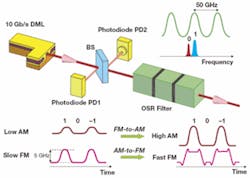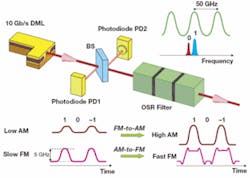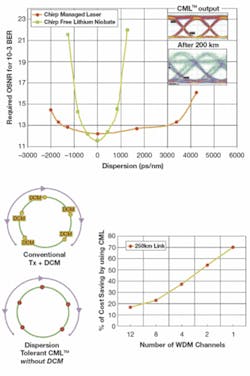Chirp-managed-laser technology delivers > 250-km reach
Chirped managed lasers leverage adiabatic chirp to increase dispersion tolerance and enable longer distance transmission.
By DANIEL MAHGEREFTEH and FRANK FAN
AZNA LLC
Until recently, directly modulated lasers were limited to very short reach (< 5-km) applications at 10 Gbits/sec. However, chirp-managed-laser (CML ™) technology can reach > 250 km at 1550 nm in standard singlemode fiber, using the simple combination of a DFB laser and a small, passive optical element. CML technology meets two market needs simultaneously: (1) The emerging metro market upgrade from 2.5 Gbits/sec to 10 Gbits/sec, and (2) the migration of small form factor pluggable optics from short reach to high-performance longer reach and WDM links.
From DML to CML
While directly modulated lasers (DMLs) are widely deployed for 2.5-Gbit/sec links, Lithium Niobate Mach-Zehnder and electro-absorption (EA) external modulators dominate at 10 Gbits/sec. The chirp of the DML broadens the signal to > 1 nm at 10 Gbits/sec, causing rapid distortion of the eye after propagation. Hence, DMLs remain limited to very short reach applications.
CMLs, by contrast, actually use the chirp of the DML to reach > 250 km at 1550 nm in standard singlemode fiber without dispersion compensation.
When a semiconductor laser is directly modulated, it generates two main types of chirp: Transient chirp, which occurs at bit transitions and hastens pulse spreading in fibers with positive dispersion, and adiabatic chirp, which makes the 1 bits blue-shifted relative to the 0 bits. A DML transmitter, which is biased near threshold, is dominated by transient chirp.
A CML comprises a directly modulated distributed feedback laser (DFB), followed by an optical spectrum reshaper (OSR) or multi-cavity etalon filter (Figure 1). The DFB is biased high above threshold to reduce transient chirp, which also leads to a low extinction ratio (ER ~ 1-3 dB) at the DFB output. However, the laser wavelength is tuned to the transmission edge of the OSR in order to attenuate the red-shifted 0 bits relative to the blue-shifted 1 bits. In this way, the OSR increases the ER to > 10 dB and produces a clean eye. The OSR also forms a wavelength locker together with two photodiodes and a beam splitter (Figure 1).
The extended reach of the CML is enabled by a fundamentally different discovery. Adiabatic chirp, together with the OSR, introduces phase correlation between the bits, which increases dispersion tolerance and reduces the information bandwidth by a factor of two. Consider a 1 0 1 bit sequence at 10 Gbits/sec where 1 bits have 5 GHz higher frequency than 0 bits. Now the phase of the carrier slips by 2 Π x 5 GHz x 100 ps = Π during the 0 bit, making the second 1 bit Π out of phase with the first. Normally, dispersion closes the eye by spreading energy of the 1 bits into adjacent 0 bits. Here, the 1 bits interfere destructively in the middle 0 bit because of the Π phase shift, keeping the eye open after fiber propagation.
A CML is well suited for 10-Gbit/sec metro systems, thanks to its wide dispersion tolerance window. Figure 2 shows the required optical signal-to-noise ratio (OSNR) to reach the forward-error-correction (FEC) threshold at 10.7 Gbits/sec for CML and zero-chirp LiNbO3 transmitters. No optical or electrical dispersion compensation is used. A CML can reach 250 km (4250 ps/nm) at an OSNR of 16.5 dB/0.1 nm. The insets depict the eye diagram at the output of a CML and after 200 km. The performance of a CML is comparable to the best duobinary transmitters; it can also be used for reaches of 80-120 km and offers a higher optical power (4-7 dBm) and better dispersion tolerance than EMLs.
Market Trends
For a number of economic and operations reasons, equipment manufacturers are moving toward line cards that employ transponders and hot pluggable transceivers as opposed to proprietary cards. This trend, usually employed in short reach applications, is gradually migrating to high-performance, longer reach and WDM applications. The benefits include shorter time to market, lower R&D costs, and higher gross margins for systems houses and network providers. The small form factor hot pluggable transceiver enables higher port density and also resolves the inventory problem since wavelengths can be plugged in as needed. One such form factor is the XFP with 10-Gbit/sec serial interconnect.
At present, CML is the only ultra-long reach technology suitable for XFP. LiNbO3 modulator-based duobinary transmitters can meet the link performance but are too large and too power hungry for XFP. EMLs can fit into an XFP but are limited to 80-km reach. Moreover, it is still a challenge to manufacture EMLs with high yield for WDM applications due to tradeoffs between output power, reach, and difficulty of wavelength alignment between the laser chip and EA section. A CML, on the other hand, meets size, power, and performance requirements up to > 250 km, and it is available on the ITU grid thanks to the availability of DWDM DFB chips.
The economics of CML versus DCM for 10-Gbit/sec Networks
Most metro regional networks are protected rings with a number of add/drop nodes and a reach of < 240 km. A wavelength may terminate at an adjacent node or, in the case of a fiber break, may travel through the protection path. Because of this, a signal may encounter different amounts of dispersion (Figure 3). For optical add/drop multiplexed (OADM) systems, a wavelength may be multiplexed and demultiplexed many times, so the total dispersion is variable. This becomes an issue at 10 Gbits/sec for conventional transmitters with small dispersion tolerance, requiring DCMs to be installed at every node. Since most networks are initially populated with one or a few wavelengths, the cost of deploying dispersion compensation, including associated metrology and engineering costs, becomes a large fraction of the deployment cost.
A dispersion-tolerant CML is ideal for avoiding this upfront cost; carriers can save the cost of installing DCMs and avoid the associated engineering costs all together. Figure 3 compares the cost of DCM and CML solutions as a function of the number of channels for a 250-km ring. The CML saves 70% for a single channel and ~ 40% for four channels. A CML also enjoys the added simplicity of channel count upgrade because it fits into a pluggable XFP.
In conclusion, CML technology offers a cost-effective solution for metro regional and WDM applications in time for the migration to 10 Gbits/sec and the industry trend toward high-performance pluggable XFPs.
Daniel Mahgerefteh is chief technology officer and Frank Fan is vice president of marketing at Wilmington, MA-based AZNA LLC. They may be reached via the company's Web site at www.aznacorp.com.


